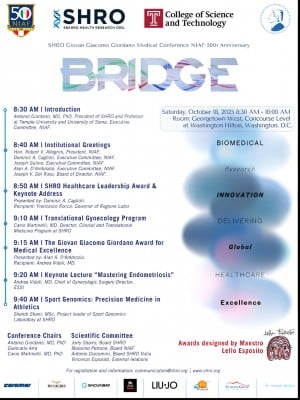Click here for today’s sports betting tips from our expert analysts!
On the back of a five-wicket win to start off this ODI series, Afghanistan tries to double their advantage over Bangladesh.
Date/time:
Venue: Sheikh Zayed Stadium, Abu…

Click here for today’s sports betting tips from our expert analysts!
On the back of a five-wicket win to start off this ODI series, Afghanistan tries to double their advantage over Bangladesh.
Date/time:
Venue: Sheikh Zayed Stadium, Abu…

Prince William’s decisions with Prince George, Princess Charlotte and Prince Louis has transformed the next generation an insider…

Newswise — WASHINGTON, D.C. – October 10, 2025 – For half a century, bridges have been built—invisible but unbreakable connections spanning the Atlantic, linking Italian medical tradition with American…

A phase 2 clinical trial (NCT06256328)1 for patients with previously untreated HER2-negative unresectable advanced or recurrent gastric cancer found that a combination of ONO-4578, an EP4 antagonist, and nivolumab (Opdivo), an anti–PD-1 antibody, resulted in statistically significant prolongation of progression-free survival (PFS). Full results will be announced at an upcoming academic meeting.2
The multicenter, randomized phase 2 clinical trial, conducted by Ono Pharmaceutical Co, took place in 63 locations across Japan, South Korea, and Taiwan. There were 210 patients enrolled who received 40 mg of ONO-4578 once daily and 360 mg of nivolumab every 3 weeks in combination with chemotherapy, until disease progression or unacceptable toxicity was observed. This treatment was compared with placebo in combination with nivolumab and chemotherapy. The primary end point of PFS was met. No new safety concerns were identified in the trial.1,2
Secondary end points included overall survival (OS), objective response rate (ORR), best overall response (BOR), duration of response (DOR), disease control rate (DCR), time to response (TTR), the maximum percent of change in the sum of diameters of the target lesions, and PFS after the next line of therapy, all measured up to 2 years.1
Treatment for ONO-4578 and nivolumab and chemotherapy included a daily dose of ONO-4578, oxaliplatin on specified days, capecitabine on specified days, S-1 on specified days, and nivolumab on specified days. Treatment for placebo and nivolumab and chemotherapy also consisted of oxaliplatin, capecitabine, S-1, nivolumab, and a placebo drug daily.1
To be eligible for the study, patients must have been diagnosed with esophagogastric junction cancer, be able to provide tumor tissue samples, and have not been treated with systemic chemotherapy as first-line therapy.1
Exclusion criteria included being unable to take oral medicines; having HER2-positive disease; having contraindications to nivolumab, oxaliplatin, S-1, or capecitabine; having a history of severe drug-related adverse reactions caused by NSAIDs; having a history of concurrent autoimmune disease; and getting headaches and/or nausea associated with brain metastasis.1
ONO-4578 is a selective oral antagonist of EP4. Its primary function is to exert an antitumor effect by suppressing EP4 mediated effects of PGE2 and by restoring cancer immunity. EP4 is one of the prostaglandins E2 (PGE2) receptors.1,2
In the phase 1 clinical trial (NCT03155061)3 in patients with unresectable advanced or recurrent gastric cancer, including gastroesophageal junction cancer, the combination of ONO-4578 and nivolumab showed antitumor effect and a manageable safety profile after the third-line or later treatment.
Ono is conducting several other clinical studies of ONO-4578, including a global phase 1 trial (NCT06547385)4 in patients with colorectal cancer. The open-label, uncontrolled study of approximately 40 patients is meant to evaluate the tolerability and safety of combination of ONO-4578 and ONO-4538 and the standard-of-care XELOX plus bevacizumab (Avastin), or the safety of ONO-4578 with ONO-4538 and the standard-of-care FOLFOX plus bevacizumab as first-line therapy, in patients with unresectable, advanced, or recurrent colorectal cancer. Ono is also evaluating the efficacy of ONO-4578 in patients with lung and breast cancer in other clinical trials.

Welcome back to the week in Playback! After a brief hiatus due to medical issues regarding yours truly (don’t worry, they’re mostly resolved), we’re diving right back into our regularly scheduled weekly recap of…

By Weston Blasi
Morgan Stanley will rely on its automated monitoring processes to make sure clients are not overly exposed to crypto
Crypto goes even more mainstream as Morgan Stanley drops restrictions for its clients.
Financial-services giant Morgan Stanley (MS) will start allowing its financial advisers to pitch crypto investments to clients with any type of account, according to a person familiar with the matter.
Prior to this change, which goes into effect Oct. 15, crypto funds were only available to Morgan Stanley clients with aggressive risk tolerance and at least $1.5 million in assets with traditional brokerage accounts.
While the move signifies a dramatic shift in the crypto industry, which is further solidifying its presence in the mainstream U.S. investing ecoystem, the question now becomes: What percentage of one’s portfolio does it make sense to have invested in crypto?
“It comes down to the individual,” Clifford Cornell, a certified financial planner at Bone Fide Wealth, told MarketWatch, noting that their clients have been eager to get into crypto. “We have a lot of conversations with clients about bitcoin. It’s one thing clients are really interested in, whether it’s actually allocating or just understanding what it is.”
Generally, Cornell said that if people come to him interested in assets outside of stocks or bonds, then he doesn’t give them a blanket asset-allocation recommendation. Instead, he may suggest setting up a separate growth-investing account – what he calls an “opportunity portfolio” – where those alternate assets can go.
“Maybe it’s more of a trade instead of an investment,” he said. “In those instances, I’d be less concerned with the percentage – whether it’s 90/10, etc. – and more concerned with what we call an opportunity portfolio.
“We never shy away from allowing clients [to invest] if they feel strongly about bitcoin, gold or an individual stock,” he added.
Prices for bitcoin( BTCUSD) reached an all-time high this week of about $126,000, before retreating back to $118,000 on Friday. The digital asset is up over 25% in 2025 to date.
“When we see a stellar year for any individual asset class, I think a lot of people get antsy,” Cornell said, explaining that clients who aren’t invested can feel left behind by a bull run in an asset.
Some other financial advisers were more comfortable giving a recommended allocation percentage for assets like crypto or gold (GC00).
Edward Hadad, a financial planner at Financial Asset Management Corp. with over 15 years of experience, recommends that speculative assets like crypto or gold should not exceed more than 5% of a person’s portfolio.
“If somebody wants to speculate, we want to ensure the totality of what we manage can still achieve your financial goals,” Hadad told MarketWatch.
See: Gold above $4,000: Is it too late to add it to your 401(k)?
And some financial institutions are making their own recommendations, too.
Morgan Stanley’s Global Investment Committee issued a paper in October outlining a recommendation of a maximum crypto allocation of 4%, according to CoinDesk. The committee described crypto as “a speculative and increasingly popular asset class that many investors, but not all, will seek to explore” – comparing bitcoin, specifically, to a scarce asset “akin to digital gold.”
Similarly, BlackRock’s Inc. (BLK) Investment Institute recommended a 1% to 2% allocation to bitcoin in 2024, while three writers from Fidelity’s investment blog suggested that portfolio allocations of 2% to 5% in bitcoin may be appropriate – and even as much as 7.5% for young investors.
Morgan Stanley’s latest crypto changes will also allow for retirement accounts to be exposed to crypto holdings for the first time. The financial planners that spoke to MarketWatch for this story were discussing potential crypto exposure in traditional brokerage accounts, not retirement accounts.
Morgan Stanley will rely on its automated monitoring processes in an effort to make sure clients do not become overly exposed to the volatile digital asset class.
See: Dow shedding over 800 points as U.S. stocks plummet on Trump’s threat of new China tariffs
Read on: Ray Dalio wants investors to have 15% of their portfolios in gold. Here’s what others think of his advice.
-Weston Blasi
This content was created by MarketWatch, which is operated by Dow Jones & Co. MarketWatch is published independently from Dow Jones Newswires and The Wall Street Journal.
(END) Dow Jones Newswires
10-10-25 1701ET
Copyright (c) 2025 Dow Jones & Company, Inc.